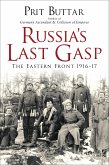In this book Prit Buttar continues his analysis and narrative on what was happening on the Eastern Front in the Great War from his previous Collision of Empires: The War on the Eastern Front in 1914 [Osprey, 2014].
He continues to make the point that most scholars focus on the dreadful suffering and stalemate on the Western Front without any consideration of what was happening on the Eastern Front. This meticulous survey reveals that the Central Powers were making measurable progress to the east with the GoliceTarnow Offensive which led to the retreat of Russian forces from Poland and the occupation of Serbia, being two examples of their advances. These successes were achieved at the expense of massive human losses, basically unreported in the west. However, amidst this success, Prit Buttar does stress that leadership weaknesses on the part of the Central Powers balanced mismanagement on a massive scale by the Russians, leading to an absence of a final success for either side.
Prit Buttar communicates his narrative and associated analysis in a very clear manner. This is a book for scholars with a focused interest. By contrast the enormity of the detail will deter the casual enquirer unless they are carefully guided to begin by exploring the opening and concluding chapters. These very carefully both set the scene and also explain what had happened over that year. With that preparation the interested reader might then explore some or all of the key events of the 1915 campaigns in the east.
Trevor James The Historian 20150901
He continues to make the point that most scholars focus on the dreadful suffering and stalemate on the Western Front without any consideration of what was happening on the Eastern Front. This meticulous survey reveals that the Central Powers were making measurable progress to the east with the GoliceTarnow Offensive which led to the retreat of Russian forces from Poland and the occupation of Serbia, being two examples of their advances. These successes were achieved at the expense of massive human losses, basically unreported in the west. However, amidst this success, Prit Buttar does stress that leadership weaknesses on the part of the Central Powers balanced mismanagement on a massive scale by the Russians, leading to an absence of a final success for either side.
Prit Buttar communicates his narrative and associated analysis in a very clear manner. This is a book for scholars with a focused interest. By contrast the enormity of the detail will deter the casual enquirer unless they are carefully guided to begin by exploring the opening and concluding chapters. These very carefully both set the scene and also explain what had happened over that year. With that preparation the interested reader might then explore some or all of the key events of the 1915 campaigns in the east.
Trevor James The Historian 20150901








